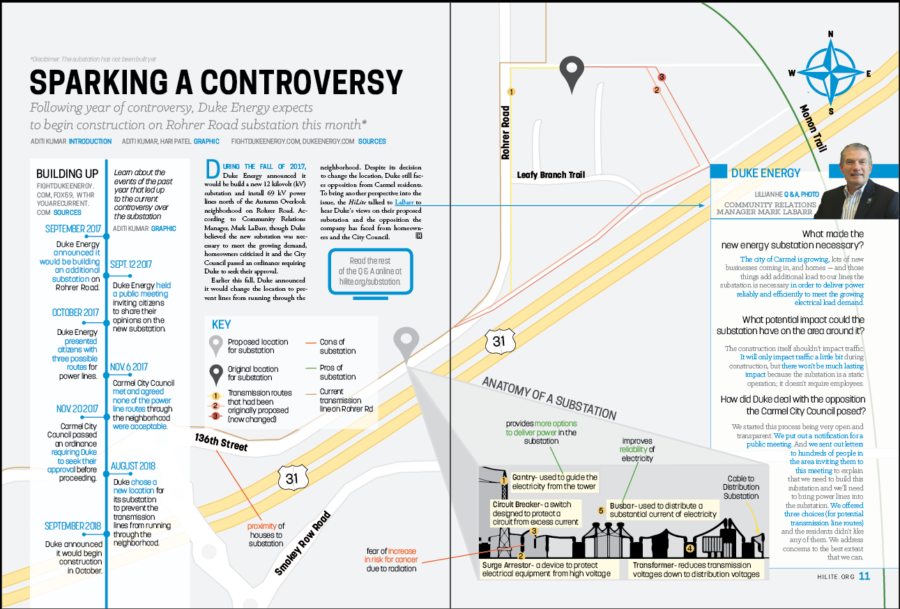During the fall of 2017, Duke Energy announced it would be build a new 12 kilovolt (kV) substation and install 69 kV power lines north of the Autumn Overlook neighborhood on Rohrer Road. According to Community Relations Manager, Mark LaBarr, though Duke believed the new substation was necessary to meet the growing demand, homeowners criticized it and the City Council passed an ordinance requiring Duke to seek their approval.
Earlier this fall, Duke announced it would change the location to prevent lines from running through the neighborhood. Despite its decision to change the location, Duke still faces opposition from Carmel residents. To bring another perspective into the issue, the HiLite talked to LaBarr to hear Duke’s views on their proposed substation and the opposition the company has faced from homeowners and the City Council.
Complete Q & A with Mark LaBarr, Duke Energy Community Relations Manager
What is your title as it pertains to this story?
I am community relations manager, so I am responsible for community outreach in the communities that we serve.
What made the new energy substation necessary?
This is necessary infrastructure. The city of Carmel is growing and it’s growing rapidly—lots of new businesses coming in, businesses and homes—and those things add additional load to our lines, so the substation is necessary in order to deliver power reliably and efficiently to meet the growing electrical load demand.
What potential impact could the substation have on the area around it?
The construction will take place over several weeks, so there’s going to be some on-site construction; the construction itself shouldn’t impact traffic. It will only impact traffic a little bit during construction, but there won’t be much lasting impact because the substation is a static operation; it doesn’t require employees. Once a month, someone might be in there to cut the grass, someone will go in to take some readings on the instruments in there, but other than that, there’s no traffic in and out of there. But during construction, certainly there will be people coming and going, trucks and that sort of thing, coming in during the morning to begin their shift and leaving at the end of the construction work day.
Will it impact property value?
That is just open for debate. We have substations all around our service territory, and not just Duke Energy but other power companies have sustations all around, and people live near the substations and people buy and sell homes near theses substations and we’re not aware of any impact on property values.
What are the general steps that have to be taken before the substation can be operational?
For it to be functional, of course, it has to be constructed. It has to come out of the ground, if you will; it has to be constructed and then it has to be connected to the transmission power line. What the substation does is it converts the 69,000 transmission level voltage into 12,000 volts, which is a more usable voltage which then goes down the street into the neighborhoods and then down along the streets either on the ground or in transmission poles to transformers, which turns 12,000 volts into 240 volts which we use in our homes; that’s what comes into your electric panel box. So in order to energize that substation—to step the voltage down from 69,000 volts to 12,000 volts—we bring in the transmission lines. Those are out on the road and we’ll bring them into the substation on poles and connect that “bus work,” a series of metal bars and so forth that’s on structures and insulators, to carry that power inside the substation.
What are the benefits of this substation?
The main benefit is reliable electric service to our customers. All of us expect that when we flip that light switch the power comes on. We take it for granted until there’s a power outage. We’re so dependent on it. The main benefit is going to be reliable electric power that could otherwise deteriorate due to that additional growth, unless we meet that electrical demand with this device.
How did Duke Energy deal with the opposition that the Carmel City Council posed?
We started this process being very open and transparent. We put out a notification for a public meeting, which we did; we held a public meeting at a church at 131st and Old Meridian Street. And we sent out letters to hundreds of people in the area inviting them to this meeting to explain to them that we need to build this substation and we’ll need to bring power lines into the substation. But back then there was the siting process. We were very open with the public; we need to construct this and here are some potential routes where we can build this transmission line to serve that substation. We offered three choices and, you know, the residents didn’t like any of them. But we’ve been very open and transparent with the neighbors that live around the substation and with the city. Substations are not popular to go in a residential area, but it’s necessary infrastructure and we listen to concerns and address those concerns to the best extent that we can.
Around when will the substation become operational?
We’re hopeful to have it operational by early next summer in the June timeframe. There may be a little bit of delay, but that’s our expected timeframe.
Is there anything I haven’t asked that you think readers should know?
I think we’ve covered that it’s not a popular thing, but this kind of infrastructure is in place all over Carmel and Indiana and the United States. People live near this infrastructure and people live fine everyday. Some folks are concerned about how are those lines impacting me with regards to maybe the electromagnetic fields around the lines, but we also put cell phones up to our heads everyday; we get near microwaves, we get near ovens, and those types of fields are already in our homes anyway near our appliances. The point is that those electromagnetic fields dissipate rapidly the further you move away from them.


































![British royalty are American celebrities [opinion]](https://hilite.org/wp-content/uploads/2024/03/Screenshot-2024-03-24-1.44.57-PM.png)


















![Review: “Suits” is a perfect blend of legal drama and humor [MUSE]](https://hilite.org/wp-content/uploads/2024/04/unnamed-1.png)
![Chelsea Meng on her instagram-run bracelet shop [Biz Buzz]](https://hilite.org/wp-content/uploads/2024/04/IMG_2446-1200x838.jpg)
![Review: Quiet on Set: The Dark Side of Kids TV is the long awaited exposé of pedophilia within the children’s entertainment industry [MUSE]](https://hilite.org/wp-content/uploads/2024/04/unnamed.jpg)
![Review: “The Iron Claw” cannot get enough praise [MUSE]](https://hilite.org/wp-content/uploads/2024/04/unnamed.png)
![Review: “The Bear” sets an unbelievably high bar for future comedy shows [MUSE]](https://hilite.org/wp-content/uploads/2024/03/unnamed.png)
![Review in Print: Maripaz Villar brings a delightfully unique style to the world of WEBTOON [MUSE]](https://hilite.org/wp-content/uploads/2023/12/maripazcover-1200x960.jpg)
![Review: “The Sword of Kaigen” is a masterpiece [MUSE]](https://hilite.org/wp-content/uploads/2023/11/Screenshot-2023-11-26-201051.png)
![Review: Gateron Oil Kings, great linear switches, okay price [MUSE]](https://hilite.org/wp-content/uploads/2023/11/Screenshot-2023-11-26-200553.png)
![Review: “A Haunting in Venice” is a significant improvement from other Agatha Christie adaptations [MUSE]](https://hilite.org/wp-content/uploads/2023/11/e7ee2938a6d422669771bce6d8088521.jpg)
![Review: A Thanksgiving story from elementary school, still just as interesting [MUSE]](https://hilite.org/wp-content/uploads/2023/11/Screenshot-2023-11-26-195514-987x1200.png)
![Review: When I Fly Towards You, cute, uplifting youth drama [MUSE]](https://hilite.org/wp-content/uploads/2023/09/When-I-Fly-Towards-You-Chinese-drama.png)
![Postcards from Muse: Hawaii Travel Diary [MUSE]](https://hilite.org/wp-content/uploads/2023/09/My-project-1-1200x1200.jpg)
![Review: Ladybug & Cat Noir: The Movie, departure from original show [MUSE]](https://hilite.org/wp-content/uploads/2023/09/Ladybug__Cat_Noir_-_The_Movie_poster.jpg)
![Review in Print: Hidden Love is the cute, uplifting drama everyone needs [MUSE]](https://hilite.org/wp-content/uploads/2023/09/hiddenlovecover-e1693597208225-1030x1200.png)
![Review in Print: Heartstopper is the heartwarming queer romance we all need [MUSE]](https://hilite.org/wp-content/uploads/2023/08/museheartstoppercover-1200x654.png)






















![Review: Ladybug & Cat Noir: The Movie, departure from original show [MUSE]](https://hilite.org/wp-content/uploads/2023/09/Ladybug__Cat_Noir_-_The_Movie_poster-221x300.jpg)

![Review: Next in Fashion season two survives changes, becomes a valuable pop culture artifact [MUSE]](https://hilite.org/wp-content/uploads/2023/03/Screen-Shot-2023-03-09-at-11.05.05-AM-300x214.png)
![Review: Is The Stormlight Archive worth it? [MUSE]](https://hilite.org/wp-content/uploads/2023/10/unnamed-1-184x300.png)






